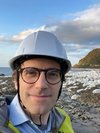In coastal regions prone to earthquakes, the landscape is shaped by the combined forces of wave erosion and rock deformation. As a result, platforms created by waves can be slowly uplifted out of the water to become marine terraces. These flat areas in otherwise mountainous coastlines are mostly known as valuable land for agriculture and urban development. For geologists they also hold precious information about past elevations of sea level, and about the rates of tectonic deformation that can result in earthquake.
To achieve this, the researchers will study the Noto Peninsula and Sado Island in Central Japan, which offer an exceptional field site with numerous marine terraces with presumed ages ranging from a few thousand years up to a million year. Some stretches of coastline are devoid of terraces while others host many. This observation is accompanied by a wide diversity of wave power reaching the coast, and varying rates of rock uplift. The goal of the project is to understand how these variations in wave conditions and rock deformation can promote or prevent the development of terraces.
To investigate the distribution and abundance of marine terraces at these sites, as well as worldwide, the researchers will develop a numerical model that simulates wave erosion and landscape evolution. They will date the age of the marine terraces to understand the local history and calibrate the model with luminescence dating techniques.
This study will lead to a deeper understanding of the tectonic and sea-level signal that is encoded in marine terraces around the world. This will help explaining the local history of tectonic deformation and associated earthquake hazard, and will provide additional constraints on sea level changes under past climates.
Field work will be jointly led by Luca Malatesta (GFZ) and Sumiko Tsukamoto (LIAG). Numerical modelling will be primarily developed at GFZ while luminescence dating will take place in the laboratory of LIAG. Two early career scientists will soon join the project. The project will be funded by Deutsche Forschungsgemeinschaft DFG.







![[Translate to English:] Eine Frau mit weißem Kopftuch und ein Mann mit dunklen Haaren sitzen vor mehreren großen Computerbildschirmen mit Messdaten und Karten.](/fileadmin/_processed_/7/f/csm_20241221_PM-GITEWS_Abb0_Kachel_2b4cf3de2f.jpeg)







![[Translate to English:] [Translate to English:] Abror Gafurov von dem Schriftzug "Welcome to Azerbaijan" und den UN und COP Logos](/fileadmin/_processed_/2/5/csm_2024_11_Baku_COP29_Abror_Gafurov_1042faec82.jpeg)


![[Translate to English:] Martin Herold standing in front of the library on the Telegrafenberg](/fileadmin/_processed_/c/d/csm_Martin_Herold_d385ee4dd9.jpeg)
![[Translate to English:] Many people are listening to a presentation in the GFZ lecture hall.](/fileadmin/_processed_/c/a/csm_1_Bild1_hell_b9c0e9f5ed.jpeg)






![[Translate to English:] Both scientists sitting on stools in front of a wall of books in the Telegrafenberg library](/fileadmin/_processed_/6/6/csm_Buiter_Castell_DORA_4_e87cb1ea18.jpeg)
![[Translate to English:] Gruppenbild mit 4 Personen](/fileadmin/_processed_/8/d/csm_20241017_GFZ-Emmerman-Medal-005_web_reinhardtundsommer_21a414fa4a.jpeg)






![[Translate to English:] Ice landscape with five red tents](/fileadmin/_processed_/8/9/csm_Zeltlager_auf_dem_Eis_Urheberin_Jenine_McCutcheon_5ced2d523b.jpeg)

